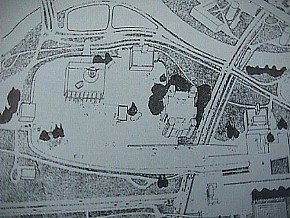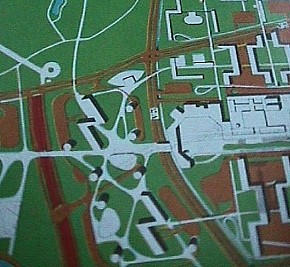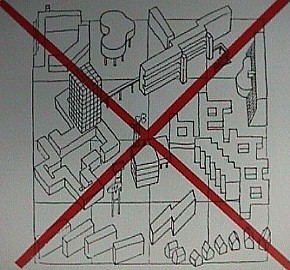2002.04.17 13:00
Re: venturi and koolhaas
I think I'm going to start writing a 'weightless' digital book entitled either:
Simplicity and Contradiction in Architecture
or
Complexity and Straight-Forwardness outside Architecture
2002.04.18 09:12
Re: venturi and koolhaas
Yes, yes, yes to all the electronics, wall as sign, Dutch silences and possible revenge(s), but how is one to be really "naughty" these days?
2002.05.06
ideas
1. houses of ill-repute--the plan is to construct a number of cad models utilizing other model parts and extruded surfaces.
2002.05.22 14:01
Re: Splintered Urbanism
What seems to missing though is any addressing of the wide spread decay that large cities manifest in parts throughout their 'life'. It seems that parts of many US cities are treated as trash and thus disposable, but where exactly does one throw out parts of cities?
2002.05.25 13:17
CQ MO
Since revisiting the Bernini double theater that I read about almost 25 years ago, I've come to greatly admire the creative fecundity of double theaters as both a means and an end within the creative process. There is something almost magical about working with a vehicle/medium where there are literally twice the possibilities and where inversion (of self, for example) and mirroring (again of self, for example) provide, again, double the possibilities. Or is it all just 'too much play(ing)' in what is really just a virtual place?
2002.05.28 10:47
Re: virtual buildings
In terms of virtual buildings (like Quondam) online, the building has to first come to you before you can go through it. Granted the visitor to a virtual building first sends a request for the virtual building to come. That's the way the Internet works right now--you can't go into a website until the website data comes to you. Relativeness is not the issue as much as inversion is.
Could it be that the more extreme a situation is, the less relative it is?
or
Could it be that the more extreme a situation is the more it begins to invert itself?
2002.05.31 14:58
High, Low, or No Rise?
It doesn't seem realistic to put virtual architecture in the category of superficial aesthetic architectures. Virtual buildings (like Quondam) do not even exist as buildings in the real world, thus lack all aesthetics that might overshadow environmental and/or political needs. Indeed, virtual buildings could be considered very environmental since they do not disturb the existing natural or man-made environment at all. Architects should begin the understand that virtual buildings can at times be a viable alternative to real buildings, especially if the virtual building can do the same job (and perhaps even a better job) than a real building--eBay is a perfect example.
I already made my thoughts on this clear within an interview conducted by Brian Carroll in June, 1999. Seeing Koolhaas make almost exactly the same statements a year later in a Wired magazine article (June 2000), indicates that I'm either just slightly ahead of the trends, or that Koolhaas takes other peoples/architects ideas and then lets the world assume the ideas are his own. Maybe Koolhaas used to visit the virtual building Quondam.
Strange how terrorists are probably the greatest users of virtual buildings so far.
| |
2002.06.19 13:00
Re: dead languages
If you read a lot of architecture theory books or essays, every so often you come across an analysis/explanation of something Victor Hugo wrote about architecture and books. Here's an example from a quondam online source:
In Victor Hugo's Hunchback of Notre Dame Book V Chapter 2 is titled "This Will Kill That". Hugo tells how human history, pre-Gutenberg, was written in its buildings: huts and temples, pyramids and pagodas, tombs and towers. Now (as of the Fifteenth Century) he argues that the printing press and its products have taken over the rôle of recording knowledge. Faster, cheaper, more democratic --- and, with widespread proliferation of books, far more imperishable than architecture. Hugo says, "The invention of printing is the greatest event of history." True? Chapter 2 concludes with a summary of his thesis:
"Thus, to put it shortly, mankind has two books, two registers, two testaments: Architecture and Printing; the Bible of stone and the Bible of paper. Doubtless, in contemplating these two Bibles, spread open wide through the centuries, one is fain to regret the visible majesty of the granite writing, those gigantic alphabets in the shape of colonnades, porches, and obelisks; these mountains, as it were, the work of man's hand spread over the whole world and filling the past, from the pyramid to the steeple, from Cheops to Strassburg. The past should be read in these marble pages; the books written by architecture can be read and reread, with never-diminishing interest; but one cannot deny the grandeur of the edifice which printing has raised in its turn.
"That edifice is colossal. I do not know what statistician it was who calculated that by piling one upon another all the volumes issued from the press since Gutenberg, you would bridge the space between the earth and the moon --- but it is not to that kind of greatness we allude. Nevertheless, if we try to form a collective picture of the combined results of printing down to our own times, does it not appear as a huge structure, having the whole world for foundation, and the whole human race for its ceaselessly active workmen, and whose pinnacles tower up into the impenetrable mist of the future? It is the swarming ant-hill of intellectual forces; the hive to which all the golden-winged messengers of the imagination return, laden with honey. This prodigious edifice has a thousand storeys, and remains forever incomplete. The press, that giant engine, incessantly absorbing all the intellectual forces of society, disgorges, as incessantly, new materials for its work. The entire human race is on the scaffolding; every mind is a mason. Even the humblest can fill up a gap, or lay another brick. Each day another layer is put on. Independently of the individual contribution, there are certain collective donations. The eighteenth century presents the Encyclopædia, the Revolution the Moniteur. Undoubtedly this, too, is a structure, growing and piling itself up in endless spiral lines; here, too, there is confusion of tongues, incessant activity, indefatigable labour, a furious contest between the whole of mankind, an ark of refuge for the intelligence against another deluge, against another influx of barbarism.
"It is the second Tower of Babel."
Interestingly, the paragraph that follows the above addresses pretty much the same idea that I thought of last night:
"So does that put the Web into a better context? Is what we're now experiencing just a step or two more along the road that Victor Hugo identified in the move from the building to the book? And is the noise of the 'Net only an increment (though perhaps an order-of-magnitude worse) to the pandemonium that the printing press has already brought us?"
Actually, what I was thinking last night is more an inversion of the prior paragraph--last night I thought to entitle my post 'virtual [architecture] inversion'.
My thoughts where about Hypertext Markup Language (HTML) as now 'virtually' killing the book. Moreover, I was thinking how HTML manifests the 'structure' of virtual architecture, thus bringing back [reenacting?] an "architecture as delivery of content".
Robert Venturi in his latest theory regarding electronics and iconography upon a generic architecture is almost saying the same thing as far as architecture again being a delivery of content, but, for me at least, Venturi's theory becomes flawed when he admits to not knowing what the content should be. More than anything, what he so far fails to acknowledge is that iconography on buildings today, be it either electronic or not, is almost always advertising, advertising, advertising--essentially a very limited, narrowly focused delivery of content. Since 1999 when I did a large number of webpages utilizing the HTML 'marquee' tag, I've wondered if HTML might not be a better 'programmer' for the 'screens' that are now on buildings (as in Tokyo and NY's Times Square and Lehman Brothers Building). For example, if I were commissioned to design content for some real (generic) building whose 'skin' was an electronic screen, I'd propose a vast series of 'webpages' that act as a museum of architecture, thereby making the building, at least on the surface, a 'virtual museum of architecture.' I wouldn't necessarily be advertising Quondam, rather I'd be cloaking real generic architecture with many architectures. It wouldn't really matter what goes on inside the building because that will probably change from year to year, and the 'bulk' of the building's real architecture will be literally superficial and ironically really virtual.
I could go on and on, like pondering what kind of content I would propose for a hospital that had screen facades, or electronic/iconographic houses that change decorations by seasons or holidays, or even imagining the imaging of a house of ill-repute.
| |
2002.07.09 13:49
Re: petition
I know what you mean.
I'm worried that some hot-shot, world-class designer will decide that reenactment is the best solution and thereby propose two huge towers that are predesigned to dramatically implode after 30 years.
You never know what crazy ideas are out there.
OOPS!
I'm sorry. I mistook Ground Zero for Crowned Nero, and thus thought the petition competition was for the next wave of Las Vegas Casinos.
Gosh, is nothing sacred anymore?
2002.07.11 11:40
Re: Parametric Design
I have used parametric tools, and I know how to use them passively and actively.
For the record, I'm utilizing to term 'parametric tools' to describe those computer aided functions / commands that require usually a set of parameters to be input for the command to follow through. For example, a rotate and extrude command needs:
1. a predrawn line formation that is to be rotated and extruded--the profile of a vase, for example.
2. two points to designate the axis around which the line formation is to be rotated, usually parallel to the profile.
3. various variables must be decided upon, e.g., how many facets should the extrusion manifest as it rotates around the axis? should the extrusion do a full 360 degrees or less?
The interesting, though not taught, part of all this is that just by slightly (or greatly) changing the angle of the axis of rotation, an entirely unpredictable extruded form will result. It is this unpredictability of what is essentially an infinite amount of possibilities that computer aided design really engenders. Only by being arbitrary with the parameters does one begin to see what all possibilities really means, or at least look like.
This is a somewhat difficult to describe with just a few words. A full demonstration with many diagrams and steps is really required. Nonetheless, look at the images within wqc/dossiers/surfaces. These images are the results of where arbitrary portions of 3-d spline lines are rotated (mostly 45 degrees) and extruded around an arbitrarily chosen axis. It is only after having done many such experiments (and being arbitrary allows for many, many quickly executed experiments) that I have begun to use this command arbitrarily but with some predictability. Essentially, I now know what some of the parameters are likely to engender.
If you think about it, the process I followed is really neither purely active or passive. I was not a slave to the programming, nor to the notion of 'finding' the right parameters for the right result. I also didn't bring any preconceived ideas to the program (such as drawing the axis of rotation always parallel to the profile). I 'played' it.
2002.09.17
Philadelphia 2026
...find out what the word is for 250th anniversary because that is the next major event year for Philadelphia and the USA.
Semiquincentennial
| |
2002.09.18 12:54
Re: what is an architectural idea?
Perhaps the real question is "What idea is an architecture?"
2002.10.20 09:44
Re: Automotive Feedback
In terms of architecture training, it would be interesting to categorize which courses teach what amounts to design and which classes teach what amounts to over-design.
2002.11.24 17:48
Re: what a difference 250 years make
You're kind of exactly right when you suggest that maybe there are too many places of "historic" significance in Philadelphia, and it is interesting that you bring to mind Piranesi and his map of the Campo Marzio because that map/plan indeed records so many of ancient Rome's historic sites even though almost none of them still existed in Piranesi's time. Moreover, it is worth also keeping in mind that Piranesi was delineating a place/city more than 1400 years after the fact. It seems almost impossible to even speculate whether, for example, the old "Indian" trail of Ridge Avenue will even still exist in 3402. Then again, it would be fun to imagine what some future Philadelphia Renaissance or Baroque period might be like. Note Franklin and Piranesi are near contemporaries; Piranesi died 1778 while Franklin was in France.
2002.12.17 17:25
Re: a Bemused Tadao Ando observation
I have studied the evolution of Kahn's architecture beyond Kahn since my own architecture thesis 1981, and Ando's Museum of Literature design appears to be a late descendant of Kahn via late 1970s Stirling and early 1980s Isozaki.
Kahn's Levy Memorial Playground designs with Isamu Noguchi (1961-66, unbuilt), and his Dominican Motherhouse of Saint Catherine de Ricci (1965-69, unbuilt) engendered much formal architectural play, a genealogy that goes mostly unnoticed by architectural historians. Much of Predock's, work, for example, especially "reenacts" the Levy Memorial Playground designs.
Interesting how you relate the Museum of Literature to a kind of themepark. It could easily be said that Kahn's formal playfulness was inspired by Piranesi's Ichnographia Campus Martius, an ultimate plan of an ancient Roman themepark if there ever was one.
2002.12.18 17:02
Re: Bemused Tadao Ando observation
What is Hadrian's Villa (AD 118-25) if not an architectural theme park?
2002.12.27 13:47
Re: WTC design reflections
While religion might be for the most part absent from thinking about the site now (officially at least), the notion of worship is nonetheless still present. I wonder how many houses of worship the WTC site could comfortably accommodate among the rest of what is (commercially and commemoratively) proposed. Do any of the new proposals specifically address pilgrimage? Or is pilgrimage only something (to be) attached to the forthcoming memorial proposals?
There are memorials everywhere all over this planet, and, unfortunately, most are soon and easily forgotten--when's the last time you went specifically to an old memorial to specifically remember what is there being memorialized? There are comparatively few memorials on this planet that are pilgrimage sites as well.
| |
2003.01.09 15:58
Re: on CR tonight 2003.01.08
I didn't mean to dismiss Holl, rather relate what I saw last night. Holl's recent MIT dorm may indeed have led to his team's final design, but I wouldn't discount the contributions of all four architects combined. Also, let's not forget the buildings Arquitectonica built/designed in the early 1980s. I believe Bernardo Fort-Brescia was the first architect I ever saw on TV.
2003.01.10 19:02
Re: the dead end of urbanism as we know it
Urbanism
Architecturism[?]
Spacism[?]
Check out Le Corbusier's plan for rebuilding Berlin (1958, a few years before the wall) at the end of volume 7 of the Oeuvre Complete. In retrospect, it is almost bizarre in its intentions. Note the reenactment of Chandigarh's Great Assembly next to the Reichstag! And the gigantic pronged towers scattered in the east. Urbanism, architecturism and spacism all in one plan.

It's funny. I really like this plan, and would love to see it executed, but not at the cost of losing Berlin in the process. If Disney, for example, ever wants to (again) do a great thematic 'FutureTown' (they actually called it TomorrowLand, didn't they?) they should simply enact this plan, and maybe put a big wall around it. I think I'd even like to live there. A kind of beyond virtual Berlin, like a new double Berlin, again.
And here's something that's really interesting in its obscurity. Remember all those little sketches depicting bad modern building design that Leon Krier used to draw as contrast to his 'good' designs? I'm betting big money that Krier actually used the axonometric of Le Corbusier's Berlin plan (OC, vol. 7, p.234) as 'inspiration'. The 'lightening-bolt buildings just south of the Tiergarten are a dead give-a-way. Now I know why I always thought those sketches were actually the best buildings Krier ever designed.
 
|